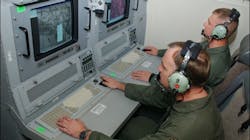Could a long-endurance UAV with ground moving target indicator (GMTI) radar replace Joint STARS aircraft?
THE MIL & AERO COMMENTARY – Nearly three decades ago, during the first Persian Gulf War, the U.S. Northrop Grumman E-8C Joint Surveillance Target Attack Radar System (Joint STARS) was among the most cutting-edge military systems ever developed.
The sophisticated radar system, packed aboard a modified Boeing 707 single-aisle passenger jet, could detect and track moving targets on the ground with something called ground moving target indicator (GMTI) technology, for which Joint STARS was one of the first and most influential applications.
This aircraft was still a prototype in 1991 during the Persian Gulf War when it detected the so-called "mother of all retreats" when the Iraqi military fled from Kuwait, which it had invaded six months earlier, in the face of U.S. and allied attacks.
Tracking data from Joint STARS enabled U.S. forces to launch devastating follow-on attacks against Iraqi military forces moving out of Kuwait, which turned the retreat into a crippling route. This ability to detect, track, and hand-off targeting information on moving enemy forces moving still today is one of the U.S. military's most important technological capabilities.
That's not the case with the Joint STARS aircraft, however. Twenty-eight years after winning fame in the first Gulf War, the Joint STARS aircraft is old, difficult and expensive to operate, and represents obsolescent technology. Could an unmanned aerial vehicle (UAV) fit this role in the future?
The 707 is based on a 60-year-old airframe design, and requires extensive re-engining and other upgrades just to keep it flying. The plane also requires a lot of people to operate -- four flight crew and 18 radar specialists.
The Joint STARS radar, based on a 24-foot antenna mounted to the bottom of the 707, was designed and built by the now-closed Norden Systems -- the same company that built the famous Norden Bombsight that during World War II guided precision bombing missions in Europe and U.S. nuclear strikes on Japan. Norden's Norwalk, Conn., facility closed in 2013. It's clear that U.S. forces still need GMTI technology, just not as it relates to the old Joint STARS aircraft.
It's unlikely that Joint STARS will survive the 2021 U.S. defense budget, and probable that the aircraft will be retired soon. Fortunately -- and thanks to the steady march of electronics miniaturization technology -- the GMTI capability that made Joint STARS famous soon will be able to fit aboard airborne platforms much smaller than the 707.
Transforming the Joint STARS aircraft into something like a Gulfstream Aerospace business jet has been discussed. GMTI technology has advanced such that it could fit aboard a small- or medium-sized unmanned aerial vehicle. In fact, IMSAR LLC in Springville, Utah, won a $7.3 million contract earlier this month to develop a synthetic aperture/GMTI radar for the Boeing Insitu RQ-21A Blackjack UAV.
That radar, called the DPY-2, is based on the IMSAR NSP-5 radar that integrates into the Blackjack's payload bay. The UAV itself is 8.2 feet long, has a 16-foot wingspan, and weighs 135 pounds with full fuel and sensor payloads. This new radar will provide high-resolution synthetic aperture radar imagery, coherent change detection, and GMTI -- much like Joint STARS.
If a Joint STARS-like GMTI capability can fit on a UAV that's less than 20 feet long, then what's the chance that the entire Joint STARS mission could be transferred to unmanned aircraft. On small UAVs the problem wouldn't be GMTI capability, but the endurance of the host aircraft.
So what about a long-endurance UAV like the Northrop Grumman RQ-4 Global Hawk? This airframe already has been modified to support the U.S. Navy MQ-4C Triton maritime patrol UAV to augment the P-8C Poseidon manned reconnaissance jet.
It almost sounds like the Global Hawk UAV is custom-made for the Joint STARS mission ... and to bring it full circle, it just might put Northrop Grumman back in the game when the Joint STARS aircraft is retired.
About the Author
John Keller
Editor-in-Chief
John Keller is the Editor-in-Chief, Military & Aerospace Electronics Magazine--provides extensive coverage and analysis of enabling electronics and optoelectronic technologies in military, space and commercial aviation applications. John has been a member of the Military & Aerospace Electronics staff since 1989 and chief editor since 1995.
